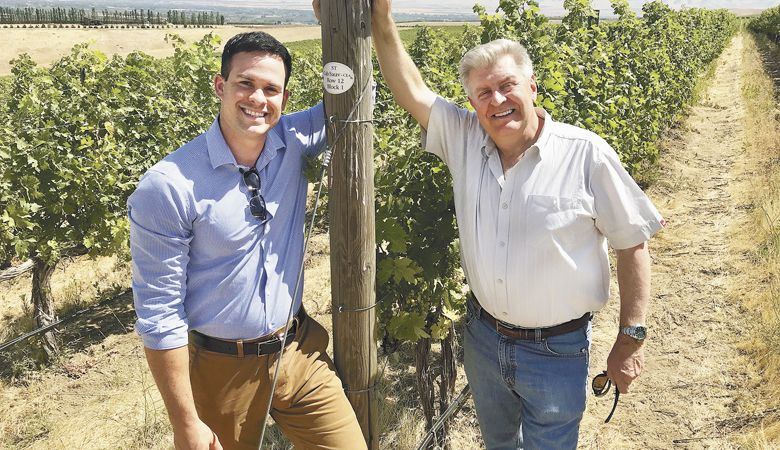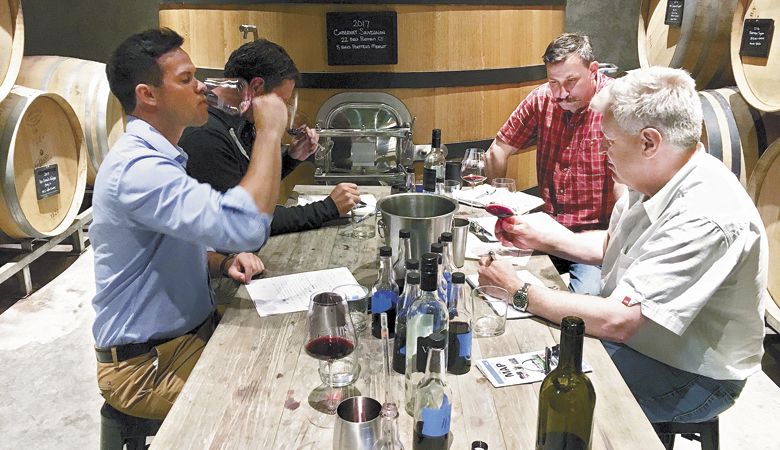Building at the Edges
Hanatoro Winery a small but mighty endeavor
By Paul Omundson
Big from small. The father-son duo of Steve Thomson and Kevin Bozada prove that concept with their innovative micro-winery in Walla Walla Valley, Hanatoro, where they craft only 200 cases of distinctive Cabernet Sauvignon all from their estate, Octave Vineyard.
Their sixth release, vintage 2017, will be available this coming fall in eight states: Georgia and South Carolina — where they do especially well — as well as Virginia, South Carolina, Massachusetts, Missouri, Kansas and Oregon. It’s no coincidence these markets are heavily populated with steakhouses and golf clubs, Hanatoro’s primary target.
“We have a lot of experience in that market, and we know what works best in those cultures,” Thomson says. “Kevin and I produce only one wine on purpose, and we put all our concentration into that. There’s no confusion about our brand.”
Their goal with Hanatoro’s Cab is to create the perfect restaurant wine. Longtime food-and-beverage guys, they know the industry well and recognize the value of wine in the leisure business. Thomson, currently the CEO of Cristom Vineyards, helped guide King Estate in sales and marketing for 17 years; Bozada is clubhouse manager at Augusta National Golf Club in Georgia. For them, the ideal “restaurant wine” is one that can flex its muscles — big, bold — and work well with a lot of different dishes and yet not overpower the food.
The secret to Hanatoro’s noteworthy success starts with the intense winds blowing through the north-facing Octave Vineyard; the breeze slightly dehydrates the grapes and thickens the fruit’s skin in the longer sunny days of June and July. “As a result, we get a higher skin-to-juice ratio and those skin tannins are soft and polished, not harsh tannins from stems, seeds and barrels. As those open up over time it’s beautiful,” Thomson explains. “We pick as late as we can and that ripe fruit, combined with those soft, polished tannins and a gentle pressing, allow us to have flavor and tannin structure that’s singing two to five years out.”
It seems fitting this boutique artisan winery, three employees strong — Steve Thomson’s wife, Karen takes care of the administrative duties — run their tiny-but-far-reaching operation in the equally wee-sized-but-internationally mighty Walla Walla Valley. The distinct patch of geography, saddling both Oregon and Washington sides of the Columbia River, produces ever-changing, intensely terroir-driven wines. Four distinct soil types, ranging from cobblestones to varying degrees of wind-deposited silt (loess), allow each vineyard lot to cultivate its own sense of place.
Thomson first discovered Walla Walla in 2003 when he was developing King Estate’s North by Northwest brand, in turn, creating friendships in the Valley. The positive relationships led to joining seven partners — now six — to plant the 27-acre Octave Vineyard, located on the Oregon side of the AVA. In 2011, Thomson stopped selling his fruit to others, finally taking the step of creating his own brand: Hanatoro. The wine almost immediately became a family endeavor with his wife and son climbing aboard.
The name, Hanatoro, is personal. Thomson explains, “It’s Japanese for ‘path of light and flowers.’ It’s a festival of heritage and community each spring in Kyoto, Japan, that my wife and I happened upon. We go back and enjoy it as often as we can. It sums up the spirit of adventure we have here, and great collaboration and camaraderie among many friends in Walla Walla.”
While securing land and planting vines represent essential pieces of Hanatoro’s prosperity puzzle, the winery’s success also comes from an alternating proprietorship arrangement with winemaker Justin Wylie of Va Piano Vineyards; he’s also one of the Octave partners. Essentially, Hanatoro owns space at the Va Piano winery in Walla Walla. “One day it might be in one area of the facility; next day, in another spot,” Thomson explains. “Wherever it may be at a particular moment, Hanatoro owns that space and also some actual equipment. It’s an arrangement that’s more common in Napa Valley than here.” In Oregon, a winemaker without a winery is more likely to have a custom-crush agreement, when a bonded winery allows other wine brands to make wine at its facility, sometimes even making wine for its clients.
Hanatoro remains Va Piano’s only alternating partnership. Wylie makes a key point: “Their fruit is absolutely phenomenal. What’s unique here is it all comes from their vineyard. When I make my own Cabernet Sauvignon, I use fruit from all over Walla Walla Valley. But this is 100% from their portion of Octave Vineyard. It uniquely reflects their own terroir. It has darker fruit, is more structured and totally their own. I love how these guys wrap their heads around what their vineyard is doing.”
Nothing demonstrates their dedication more than the Hanatoro summer get-together: two days of blending trials with Wylie. Collectively, they taste the barrels, nailing down specifics on blends that will make up the vintage. Like chefs choosing spices for a dish, they are determining how much Cabernet Franc, Malbec and Petit Verdot to blend with the Cabernet Sauvignon, taking into account clones, barrel characteristics and more.
Toward the end of the process, the three go out to dinner, taking some blending hopefuls to assess them with various food pairings. A final test, of sorts. “We’ll make stylistic shifts as we go along,” Bozada assures.
After the wine is solidified, it’s time for pinpoint sales and marketing: the crème de la crème of the Hanatoro operation. Bozada remains the relationship guy, the one who personally interacts with sommeliers and others most often. He’s built an impressive cadre of contacts, especially in the South. Thomson, on the other hand, offers overall context and direction. Throughout his long career, he’s earned a reputation as one of the most knowledgeable experts in the food and beverage industry.
“Most wineries start out selling directly and in their home state first with distribution, very gradually adding to that but generally staying fairly regional for a long time,” Thomson explains. “I’m a big proponent of building business out at the edges and working back in toward the winery. This approach requires laser-focused brand planning, positioning and sales targeting. A winery needs to really know where and how it wants to compete for space on wine lists and on store shelves, even at the smallest sizes.”
In Hanatoro’s case, things might not be so tiny in the future. The upcoming 2017 release will remain at eight barrels (192 cases) but likely double and triple in two to five years. That’s the plan. Bozada predicts eventually leveling out at 1,000 cases. The two admit they are talking about adding another wine or two to the lineup, possibly a white such as Sauvignon Blanc, but only if they can find a single-designate vineyard if they need to source fruit.
“Sense of place means everything,” Bozada emphasizes, which is why Hanatoro is in Walla Walla Valley. Thomson adds, “We’re taking it a step further and defining a sense of place in where we want to sell our wines, too.”












